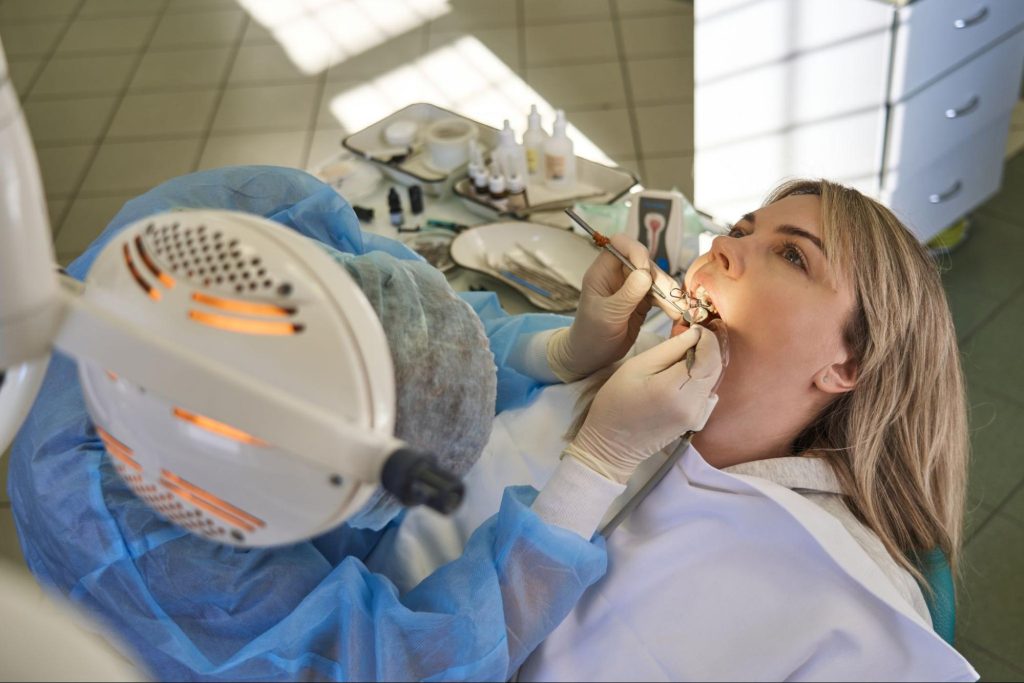Getting a dental crown isn’t just another appointment; it’s a real decision. Whether you’re repairing damage or restoring confidence, the process matters. People often feel uneasy when they are unsure of what to expect at the dentist. Understanding the steps can help turn stress into relief and prepare you confidently. The proper knowledge enables you to stay calm, make better choices, and protect your smile in the long term.
What is a Dental Crown Procedure?
A dental crown procedure repairs and protects a weakened or damaged tooth. It restores the tooth’s shape, size, and function while improving its appearance. Crowns act like protective caps that shield teeth from further harm. This treatment is routine and safe, often preventing the need for more invasive procedures later.
Why You Might Need a Dental Crown
Teeth can wear down, crack, or decay over time. A crown restores the tooth’s structure and function. Dentists recommend crowns after root canals, large fillings, or fractures. You might also need one for cosmetic reasons if a tooth looks misshapen or discolored. Regardless of the cause, the goal is to protect what’s left and restore your bite.
Types of Dental Crowns Used Today
Dental crowns come in several types, each with different benefits. Porcelain and ceramic crowns are carefully matched to your tooth color for a natural appearance. Metal crowns, such as those made of gold or an alloy, offer strong durability but are more visible. Zirconia and composite crowns strike a balance between strength and appearance. Dentists choose treatments based on the location, function, budget, and cosmetic goals of the teeth.
How a Dental Crown Differs From Other Restorations
Crowns cover the whole tooth, unlike fillings or veneers. A filling repairs a small area, while a veneer covers only the front. Crowns support chewing, restore alignment, and prevent further cracking. For teeth with deep damage or structural loss, crowns offer complete protection. They’re often the last step before tooth replacement becomes necessary.
Step-By-Step Dental Crown Procedure Explained
The dental crown process typically involves two visits, though same-day crowns are an option in some clinics. Each stage is carefully planned to preserve as much of your tooth as possible. You’ll be informed, numbed, and treated to minimize discomfort. Knowing each step helps you feel more in control of your care.
1. Initial Consultation and Dental Examination
Your dentist begins with a comprehensive checkup and a review of your medical history. X-rays help assess root health and check for hidden decay. They also evaluate gum health and jaw alignment. If the tooth can be saved, the dentist will recommend a crown. You’ll discuss crown material, timing, and what the treatment will involve.
2. Tooth Preparation and Temporary Crown Placement
The tooth needs to be reshaped to fit the crown snugly. First, the dentist numbs the area for comfort. Then, they remove any damaged or decayed parts of the tooth. A mold or digital scan captures the shape of the permanent crown. Meanwhile, a temporary crown protects the area while your final one is made.
3. Creating the Final Custom Crown
Your permanent crown is crafted in a lab or in-office using special tools. Technicians shape and color-match it to blend with your natural teeth. Lab-made crowns can take one to two weeks to be made. Some offices use CAD/CAM tech for same-day crowns. Either way, precision is key to a comfortable and lasting result.
4. Fitting and Securing the Permanent Crown
Once your crown is ready, the dentist removes the temporary one. They place the new crown over your prepared tooth to check the fit and bite. Minor adjustments may be needed to fine-tune comfort and alignment. Then, they cement it in place using a strong dental adhesive. You’ll leave with a functional, restored tooth that looks and feels natural.
5. What Same-Day Dental Crown Procedures Involve
Same-day crowns eliminate the wait by utilizing 3D imaging and milling machines. After tooth preparation, a scan is taken instead of a mold. The digital file guides the creation of the crown right there in the office. Within hours, the new crown is polished, adjusted, and bonded. It’s faster, but it depends on your dentist’s equipment and training.
What to Expect After the Dental Crown Procedure
Once your permanent crown is in place, your tooth is protected again. Still, some soreness or sensitivity may follow for a few days. Understanding what’s normal versus what’s not can help you recover smoothly. It’s important to follow instructions and know when to call your dentist.
Sensitivity, Discomfort, and Recovery Timeline
At first, some sensitivity to temperature or pressure is common. The gum around the tooth may feel tender for a few days. If needed, over-the-counter pain relief can help. Most people adjust fully within one to two weeks. If the pain worsens or persists, contact your dentist for a thorough examination.
Eating, Drinking, and Returning to Normal Habits
Wait until numbness fades before eating to avoid biting your cheek. Start with soft foods and avoid sticky, chewy, or hard items for a day or two. After that, you can eat as you usually would. Crowns are tough, but chewing ice or biting fingernails can still cause damage. Stay mindful and chew with care when possible.
Daily Care and Oral Hygiene With a Dental Crown
Brush and floss like you would with any natural tooth. Use a non-abrasive toothpaste to avoid wearing down crown material. Pay special attention to the gumline around the crowned tooth. Rinsing with mouthwash can reduce bacteria and irritation. Routine cleanings every six months help maintain the health of crowns and gums.
How Long Dental Crowns Last and When to Replace Them
A well-made crown can last ten to 15 years or more. Ceramic and metal crowns tend to last the longest with proper care and maintenance. Habits such as grinding, poor brushing, or skipping checkups can significantly shorten one’s lifespan. If the crown loosens or cracks, it may need replacement. Dentists will monitor it during visits to catch issues early.
Warning Signs That Something May Be Wrong
Pain when biting or ongoing soreness may signal a loose crown. Sensitivity that doesn’t fade can indicate an inflamed nerve. A chipped or cracked crown weakens its protection. If the crown moves or shifts, it needs urgent attention. Don’t wait; address minor problems before they become bigger ones.

Cost Expectations for a Dental Crown Procedure
Understanding the cost of a dental crown procedure helps avoid surprises. Prices vary depending on the materials used, the dental office’s location, and whether insurance helps cover part of the cost. While some may be tempted to shop for the lowest rate, long-term quality should take precedence. A poorly fitted or rushed crown often leads to more procedures and higher costs later.
Factors That Affect the Final Cost
Several factors shape the cost of a dental crown. The type of crown you choose—ceramic, metal, zirconia, or porcelain-fused—can dramatically change the price. Your dentist’s experience and whether advanced imaging is used also matter. Geographic location plays a part, as urban practices tend to charge more. Additional procedures, such as root canals or core buildups, increase the total fee.
Average Price Ranges Based on Crown Type
Dental crowns typically cost between $800 and $2,500 per tooth without insurance. Porcelain or ceramic crowns typically range from $1,000 to $1,500. While less natural-looking, metal crowns can range from $900 to $2,000, depending on the metal used. Due to their strength and aesthetics, Zirconia crowns often sit at the higher end. Composite resin crowns are less expensive but tend to wear down faster over time.
What Insurance Typically Covers
If you have dental insurance, it may cover up to 50% of the cost of the crown procedure. However, coverage depends on your plan, annual maximums, and whether the treatment is medically necessary. Some plans do not cover cosmetic crowns or those placed solely for aesthetic purposes. Always check with your provider before scheduling. A pre-treatment estimate can help you plan your budget with clarity.
Why Cheaper Isn’t Always Better
Choosing the lowest-cost option may seem wise, but it can backfire. Cheaper crowns may be made from less durable materials or be poorly fitted. If a crown fails early, you’ll pay more for repairs or replacements. A well-placed, high-quality crown done right the first time saves money and stress. Long-term value matters more than just upfront savings.
Risks and Complications of the Dental Crown Procedure
Most dental crown procedures are performed smoothly and yield lasting results. Still, no treatment is without some risk. While problems are rare, knowing what might go wrong and how to address them is prudent. Knowing the signs of a problem helps you get help before it worsens.
Tooth Sensitivity and Nerve Irritation
Some people experience sensitivity to heat or cold after having a crown placed. It is usually temporary and fades within days or weeks. If the tooth was filled deeply, the nerve may react more strongly. In rare cases, the nerve dies and requires a root canal. Always mention lingering sensitivity at follow-up appointments.
Crown Doesn’t Fit Properly
A crown that feels too high or misaligned can affect your bite. It may cause pain while chewing or create strain on your jaw. If caught early, dentists can quickly adjust the crown. Ignoring a bad fit can wear down other teeth or damage the crowned tooth. If the crown shifts or feels loose, contact your dentist right away.
Gum Inflammation or Recession Around the Crown
Poor margins or rough crown edges can irritate the gums, leading to inflammation, swelling, or bleeding while brushing. Over time, gum recession may expose the edge of the crown or the tooth beneath it. Proper cleaning and regular checkups help prevent this. A dentist can polish or adjust the crown to reduce irritation.
Decay Under the Crown
A crowned tooth can still get cavities if bacteria reach underneath. It often happens when crowns aren’t sealed tightly or oral hygiene slips. Decay under a crown may not cause pain initially, making it difficult to detect. Eventually, it weakens the tooth and may require extraction. Flossing and routine dental exams help catch these issues early.
Crown Fractures or Chips
Though crowns are strong, they can still crack or chip under pressure. Biting ice, chewing hard foods, or grinding your teeth increases this risk. Small chips might be repaired, but large fractures often need full replacement. Avoid using your teeth as tools or chewing pens. A night guard can protect against grinding while you sleep.
Know What’s Coming With a Dental Crown Procedure
A dental crown isn’t just about fixing your tooth; it protects your health, comfort, and peace of mind. Getting familiar with the process removes the guesswork, so you can walk into your appointment ready for anything.
Want answers you can trust? Discover expert guidance on the Meader Family Dentistry blog now.






